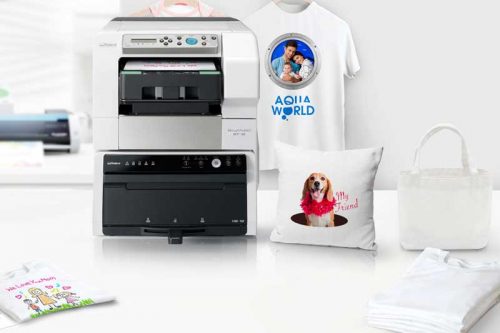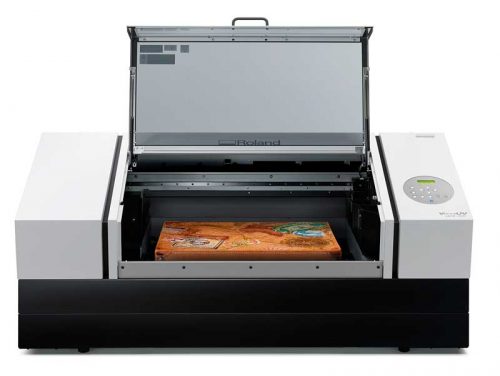Compassion and Innovation: Digital printing industry responds to COVID-19
by | 21 December 2020 7:36 pm
By Ginny Mumm
 [1]
[1]Despite the chaos and disruption brought on by COVID-19, industry manufacturers continue to work on new applications, outreach, and technology, which will create exciting business opportunities in 2021.
It is obvious 2020 has been anything but a typical year. In fact, one could say there have been two distinct parts to the year: the first quarter and COVID-19. The pandemic has affected every business, including digital print.
As many industries have done, the digital printing sector has responded to the pandemic with compassion and creativity. Here is an overview of current trends, the state of technology in the sign industry, how the crisis has affected the business, and a glimpse of what the future holds, both in terms of technology and the industry overall.
Textile printers—offering flexible solutions and new applications
Early in the year, the market for printed textiles was rapidly expanding. In fact, according to the Allied Market Research report ‘Global Digital Textile Printing Market by Ink Type, Substrate, Application: Global Opportunity Analysis and Industry Forecast, 2020–2027,’ the global digital textile printing market was projected to grow at a compound annual growth rate (CAGR) of 19.1 per cent between 2020 and 2027. Manufacturers were offering a range of options for print-service providers (PSPs) who were looking to broaden their product offerings with direct-to-fabric and/or dye-sublimation transfer printing.
When the COVID-19 crisis began, these businesses moved quickly to respond.
“As soon as the pandemic hit, we knew how hard the impact was going to be for our industry,” said Lily Hunter, Roland DGA’s product manager for textiles, e-commerce, and supplies. “We reached out to our dealers and customers to make sure they and their families were OK, and to ask if we could provide any help and resources.”
Since many print shop owners are home-based or small business operators, many PSPs developed resources to help raise awareness that print shops were often considered ‘essential businesses’ and, therefore, should be allowed to remain open. Several print technology manufacturers also responded with virtual outreach programs.
 [2]
[2]Hunter predicts with the changes brought on by the pandemic, online shopping and e-commerce will only continue to grow.
Hunter said throughout 2020 and especially after COVID-19 hit, there has been an increased interest in home-based business solutions.
“If you can send a job to a desktop printer, you can design and send a print job to a direct-to-garment printer,” she said. “Customized T-shirts are a great way to make money and can be sold through your own website, or through sites like Etsy and Facebook Marketplace.”
Hunter predicts with the changes brought on by the pandemic, online shopping and e-commerce will only continue to grow.
“My best advice for companies is to establish these channels now,” said Hunter.
That said, soft signage is still relevant in today’s marketplace.
“This signage type makes a good backdrop for virtual meetings, conferences, and trade shows, and they definitely look better than video conferencing software generated backgrounds,” she said. “In addition, soft signage remains a great alternative to polyvinyl chloride (PVC) banners. Further, sublimated soft signage is washable. Anti-microbial media also became increasingly popular as businesses, schools, and places of worship opened up.”
Hunter predicts wellness and disease-prevention measures will remain important in the future.
“As surfaces need to be cleaned more frequently to comply with health guidelines, printed products and signage need to be able to withstand various types of chemicals and cleaning methods. Inks not only need to be vibrant, but also durable,” she said.
In Hunter’s opinion, printing equipment must continue to be user-friendly, robust, and reliable to meet the growing needs of new customers, specifically home-based businesses.
“Beyond offering printing and ink technology, we cannot ignore the importance of providing excellent support,” said Hunter. “Virtual support and relevant resources must be available for users at any given time. The more user-friendly your products and resources, the better it is for your new and growing customer base.”
UV printers—customization for a new era
 [3]
[3]Smaller direct-to-garment (DTG) printers allow even inexperienced users to quickly and affordably produce custom apparel.
Like many segments of the digital printing industry, ultraviolet (UV) printing was going strong in the early part of 2020. With COVID-19, technology manufacturers took a step back to evaluate what had changed.
“The sign industry paradigm suddenly shifted to: we need this now,” said Jay Roberts, Roland DGA’s product manager for UV products. “End-users quickly began generating large amounts of signage for closures, new business practices such as take-out only, and crowd management. These signs were vital to keeping companies in touch with their clients throughout the crisis and into the phases of reopening.”
A trend that has remained consistent in the UV market throughout 2020 is the demand for higher quality printing.
“Viewing distances are closer these days, and marketing graphics often include photographs. Both of these factors require high-quality printing to ensure graphics are clear and effective,” said Roberts.
He has observed industries from retail to real estate are demanding more sophisticated signage and graphics. Restaurants are also upgrading their signage to include high-quality images of their food for socially distant viewing.
Manufacturers are responding with high-volume, high-quality equipment, which can print directly onto larger media boards with higher height clearance. They are also offering colour management software solutions and tools to help print shops easily manage colour across production devices.
While Roberts notes the personalization trend has slowed with a lack of in-person events, the customization of gifts has not. Specialized benchtop flatbed UV printers meet this demand, offering versatility and high-quality printing on a wide variety of objects. Some even allow UV direct printing on popular vacuum-insulated, stainless-steel drinkware and other accessories.
Other trends continue, including print-for-pay applications, as well as label production and packaging prototyping. Manufacturers are offering wide-format UV print solutions that can produce one-off and short-run labels, packaging prototypes, gloss/matte finishes, realistic textures, and 3D embossed effects.
For 2021, some manufacturers are adding products that will help simplify colour management along with improved UV inks.
“By staying attuned to customers’ needs, businesses can continue to introduce innovative ways to improve output and simplify production,” said Roberts.
Colour products—versatile production platforms help PSPs pivot
 [4]
[4]Benchtop flatbed ultraviolet (UV) printers like Roland DG’s VersaUV LEF2-300D, with a height clearance of 199.9 mm (7.87 in.), allow direct printing on a wide range of objects and address the ongoing demand for customized gifts.
When COVID-19 hit, colour products manufacturers experienced much the same drastic change as other sectors in the digital printing market.
“There was a big shift all of a sudden, and it was region specific—each region had a different view of what was happening,” said Roland DGA’s product manager for digital print, Daniel Valade.
One thing was consistent across the various areas, however. Everyone was producing tons of directional and safety signage and floor graphics.
“Suddenly everyone started looking down to check— am I going in the right direction? Am I maintaining my distance?” said Valade. “In addition to the safety factors, it’s a tremendous advertising opportunity.”
The trend toward quality print production is also prominent in the colour products sector.
“My local 7-Eleven is a great example,” said Valade. “Their signage used to be black and white and printed on copy paper. Now they have colourful corporate signage that guides customers through the store.”
To more easily hit those corporate colours, manufacturers are expanding their ink ranges.
Personalization and customization trends also continued through 2020 as brands moved their businesses online and smaller, home-based businesses entered the marketplace. Small-format, affordable equipment provide a robust yet easy-to-use platform, allowing users to quickly build a T-shirt, poster, sticker, and decal graphics printing business.
Manufacturers are also looking for ways to stay connected to their clients. For example, virtual conferences and in-person, limited attendance appointments are designed to provide valuable ideas and insights for maximizing business growth, productivity, and profitability.
Into 2021, Valade expects the push for superior output to continue, with manufacturers developing options like increased colour gamut. He also expects corporate buyers who might have held off on purchasing printers during this uncertain time to capitalize on the range of technology that will be available.
“Next year will bring new printing technologies, and I predict the industry will continue to emphasize quality above speed,” he said.
Continue building on what has been learned
 [5]
[5]Today’s wide-format printers meet the industry’s need for high-quality graphics, produced at high-volume production speeds.
Roland DGA’s president and CEO, Andrew Oransky, said although the first half of 2020 brought decreased activity in every segment, “there have been some bright spots.”
Signage is one area that saw some resurgence, as businesses needed safety and general procedure signage. The new normal has also created some unique opportunities, like graduation yard signs, and some customers who produce wraps have seen a surge as many home improvement and maintenance contractors are busy right now and are upgrading their fleets. With a majority of people staying close to home, there has been a boom in renovation projects.
Oransky forecasts there will be continued softness in the market through the end of 2020. However, with businesses reopening and reimagining their deliveries, signs and graphics will continue to be in demand.
“Stay flexible, and have written plans in place for how you will pivot if there’s resurgence,” advised Oransky. “The work we’ve already done means transitions will be smoother, and operations will continue with fewer interruptions.”
He expects the adoption of web-to-print to accelerate.
“For the foreseeable future, in-person customer interactions will decrease. Luckily for the print industry, the technology to deal with this already exists,” he said.
Oransky predicts remote work is also here to stay which, for some businesses, might mean an opportunity to get a good deal on space. For others, it may mean rethinking what they already have and scaling back or subletting.
“Any shift in the commercial real estate market inevitably creates opportunities for graphics, signage, and other types of printing,” he added.
Despite the chaos and disruption brought on by COVID-19, industry manufacturers continue to work on new applications, outreach, and technology, which will create exciting business opportunities in 2021.
Ginny Mumm is a freelance consultant for digital inkjet printer/cutter provider Roland DGA. For more information, visit www.rolanddga.com[6].
- [Image]: https://www.signmedia.ca/wp-content/uploads/2020/12/VehicleWrap_Wildfire_Roland_DG_TrueVIS_VG2-640_printer-cutter.jpg
- [Image]: https://www.signmedia.ca/wp-content/uploads/2020/12/Roland_DG_VersaSTUDIO_BT-12_direct-to-garment-printer.jpg
- [Image]: https://www.signmedia.ca/wp-content/uploads/2020/12/T-shirt_Roland_DG_VersaSTUDIO_BT-12_direct-to-garment_printer.jpg
- [Image]: https://www.signmedia.ca/wp-content/uploads/2020/12/Roland_DG_VersaUV_LEF2-300D_flatbed_UV_printer.jpg
- [Image]: https://www.signmedia.ca/wp-content/uploads/2020/12/Vehicle_Wrap_GorgonRacing_Roland_DG_TrueVIS_VF2-640_printer.jpg
- www.rolanddga.com: https://www.rolanddga.com/
Source URL: https://www.signmedia.ca/compassion-and-innovation-digital-printing-industry-responds-to-covid-19/